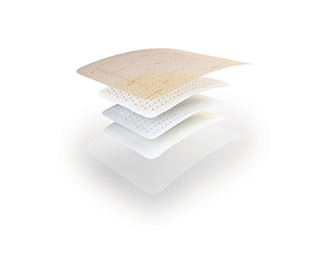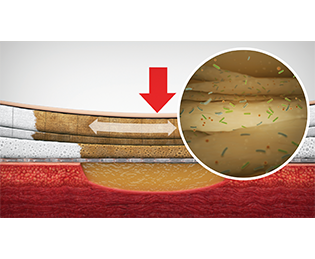Mepilex dressings use state-of-the-art technology
To promote efficient healing
Care & Nursing Essentials editor Victoria Galligan heard three different views on the new Swedish-deigned dressing Mepilex, which promise to decrease healing time and reduce infection…
DEVELOPER – Molnlycke
How and where were the dressings developed?
Mepilex dressings were developed by Molnlycke, we are a Swedish-based leading medical solutions company that equips healthcare professionals to achieve the best patient, clinical and economic outcomes. Mepilex Border Comfort was developed with proprietary Flex Technology – the benefits of which have been analysed using an established method called finite element modelling.
They also incorporate the new Exudate Progress Monitor – a dot pattern that allows you to easily track and record fluid as it spreads, without disturbing the wound.
Which features make the dressings so effective?
Mepilex Border Comfort addresses the challenges that many patients with chronic wounds face. The Cutting-edge Flex Technology means that the dressing can adapt to every day movement, allowing it to stay in place for longer and making wear more comfortable. 
Not only that, but superior exudate management means the dressing more effectively handles fluid and traps bacteria, reducing concerns about infection and meaning that dressings need to be less frequently changed.
PATIENT –
Nicholas Booth
How long have you had the wounds for, are they new wounds or have you been suffering for a while?
There have been two wounds, the first on my right leg and the second on my left. Both are on the Achilles tendon (pictured).
I picked up the first wound in about April last year. It was my own fault. I wore some weights around my ankle in order to exercise my legs more while walking my dog. These was some abrasion to the back of my leg but I ignored it as cuts always heal up. This time the cut didn’t. I didn’t notice at first, but pain started to build up. By May, it was hurting enough to make me go to a drop-in centre.
I thought it might be too trivial to bother them with but the nurse said: “You’ve got an ulcer. You must get this properly treated.” She told me to go down to my GP personally and make sure I got an appointment to see the practice nurse. Ever since that day I’ve been in pain.
I have oedema, which makes the legs swell up, and if you have a cut that forces your wound, however tiny, to swell up too. When I used to take bandages off I used to dread looking at the results. It’s like watching your leg slowly burst open.
How did the Mepilex dressings help?
At one stage the bandages I was using (bought from supermarkets) were roughing up the skin around the wound, which effectively spread the area of pain. I never had that problem with the Mepilex bandages. They stay on too, which is a massive relief, as some of my bandages were coming off. The padding is brilliant too. At one stage, when I was cycling, I accidentally clunked the back of my ankle against the spiky bike pedal. I was in the middle of Richmond Park, swearing like hell and wailing, because the bandage I had on that day had given me no protection. The Mepilex give you a bit of protection. They stick to you like limpets too, without being uncomfortable. They also seem fairly absorbent and are very comfortable. It’s a shame I didn’t discover them earlier.
Would you recommend them to a friend over other dressings, and if so, why?
Oh absolutely. The application of the dressing, and keeping it in place, is crucial and the Mepilex is easily the best bandage for holding everything in place. At times, when I (or the medics) used other bandages, I was in agony when the bandage or the dressing slipped.
I think Mepilex is great, used in conjunction with a support stocking.
DOCTOR –
Dr Paul Chadwick
What are the common issues with regular dressings?
There a lots of issues related to conformability and adhesion particularly on difficult to dress areas such as the feet. This leads to slippage and trauma to the wound and periwound and can prolong treatment time and increase risk of complications such as infection. 
With dressings that you can leave on for a week, isn’t there an increased risk of infection?
There is no increased risk of infection providing the wound dressing is designed to be in place for that period. The risk is the development of infection which can occur whether the dressing is on for two days or seven and it is undetected. This is a particular issue in patients who have neuropathy (loss of feeling commonly seen in people with diabetes) where pain may not be present.
In all cases patients should be encouraged to check the surrounding area and report any signs of heat, redness, swelling, odour and pain. Equally the patient should report urgently if they have any flu-like symptoms such as temperature. It is recognised in other areas of practice that things remain undisturbed for a week. For example in diabetic foot management gold standard treatment for a non-ischemic non-infected foot ulceration a total contact cast is used which remain undisturbed for a week.
Are there cost savings to be made with Mepilex?
Considering they require fewer changes, this will no doubt reduce staffing costs, and the reduction of secondary complications such as trauma associated with continually removing dressings will reduce costs.

